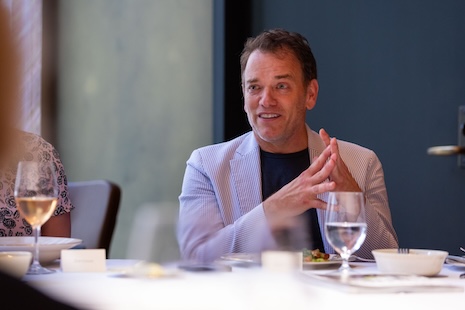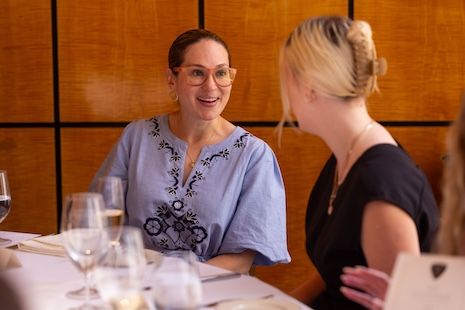 The Heesen Yachts x Luxury Roundtable Luncheon in New York June 19 brought together, from left to right, The RealReal's Caroline Mayhew Gardner, Mojo Stumer's Mark Stumer, Heesen Yachts' Sara Gioanola, Douglas Elliman's Scott Durkin and Luxury Roundtable's Mickey ALAM KHAN. Image: Jonathan Heisler
The Heesen Yachts x Luxury Roundtable Luncheon in New York June 19 brought together, from left to right, The RealReal's Caroline Mayhew Gardner, Mojo Stumer's Mark Stumer, Heesen Yachts' Sara Gioanola, Douglas Elliman's Scott Durkin and Luxury Roundtable's Mickey ALAM KHAN. Image: Jonathan Heisler
NEW YORK – Personalized and digitalized: those two experiences will drive spending behavior for the next-generation wealthy, particularly millennials and Gen Z.
A luncheon roundtable June 19 organized by Dutch superyacht builder Heesen Yachts in partnership with Luxury Roundtable sought to gain clarity into the lifestyle and consumption patterns of younger consumers, either self-made or heirs to wealth. A consensus quickly developed that Gens Y, Z and even older Alpha were more self-aware, upping the ante for luxury brands looking to impress them.
“Self-informed consumers are more self-directed,” said Mickey ALAM KHAN, CEO of Luxury Roundtable, and cohost of the Heesen Yachts x Luxury Roundtable Luncheon at The Grill restaurant in the Seagram Building in midtown Manhattan.
 The Heesen Yachts x Luxury Roundtable Luncheon participants June 19 in New York. From left to right: Worth's Eva Crouse, @theyachtfella's Kevin Koenig, The RealReal's Caroline Mayhew Gardner, Mojo Stumer's Mark Stumer, Douglas Elliman's Scott Durkin, Heesen Yachts' Sara Gioanola, Hannah Seligson, Luxury Roundtable's Mickey ALAM KHAN and Sekoya Communications' Sophia Wilson. Missing from this photo: Business Insider's Maddie Berg. Image: Jonathan Heisler
The Heesen Yachts x Luxury Roundtable Luncheon participants June 19 in New York. From left to right: Worth's Eva Crouse, @theyachtfella's Kevin Koenig, The RealReal's Caroline Mayhew Gardner, Mojo Stumer's Mark Stumer, Douglas Elliman's Scott Durkin, Heesen Yachts' Sara Gioanola, Hannah Seligson, Luxury Roundtable's Mickey ALAM KHAN and Sekoya Communications' Sophia Wilson. Missing from this photo: Business Insider's Maddie Berg. Image: Jonathan Heisler
The roundtable participants included Scott Durkin, president/CEO of Douglas Elliman Real Estate, one of the nation’s preeminent independent luxury real estate brokerages; Mark Stumer, principal of the Mojo Stumer architectural firm with assignments in luxury residential and commercial real estate nationwide; and Caroline Mayhew Gardner, head of integrated brand marketing and experience at The RealReal, the country’s leading reseller of luxury apparel and accessories.
Sara Gioanola, PR and press office manager for Heesen Yachts, was cohost. Sekoya Communications associate director Sophia Wilson organized the event in conjunction with Luxury Roundtable.
 Luxury Roundtable CEO Mickey ALAM KHAN moderating the Heesen Yachts x Luxury Roundtable Luncheon discussion with select brands and media on what's next for the next-gen wealthy. Image: Jonathan Heisler
Luxury Roundtable CEO Mickey ALAM KHAN moderating the Heesen Yachts x Luxury Roundtable Luncheon discussion with select brands and media on what's next for the next-gen wealthy. Image: Jonathan Heisler
Also in attendance were Maddie Berg from Business Insider, Eva Crouse from Worth, Hannah Seligson, who strings for The New York Times and The Wall Street Journal, and Kevin Koenig, one of the top marine journalists.
 From left to right: Business Insider's Maddie Berg and The RealReal's Caroline Mayhew Gardner. Image: Jonathan Heisler
From left to right: Business Insider's Maddie Berg and The RealReal's Caroline Mayhew Gardner. Image: Jonathan Heisler
Peering out
Among her many observations, The RealReal’s Ms. Gardner pointed out that personalized experiences and peer-to-peer recommendations play a key role in next-gen decision-making.
For example, older wealthy women consumers are finding that their daughters often do not want their clothes – good business for The RealReal, but reflective of vastly differing tastes between generations.
Rather, these younger wealthy consumers turn to the Internet and social media, in particular, where they rely on the recommendations of their peers to guide their lifestyle preferences and then tweak them. The Internet has driven more of an individual lifestyle versus collective, Ms. Gardner said.
 The RealReal's Caroline Mayhew Gardner discussing next-gen wealthy attitudes to fashion and luxury. Image: Jonathan Heisler
The RealReal's Caroline Mayhew Gardner discussing next-gen wealthy attitudes to fashion and luxury. Image: Jonathan Heisler
In good news/bad news, she is finding that the younger wealthy cohort is more self-aware with always-on online and mobile connectivity. The flip side to being more self-informed is that these consumers are not as brand loyal, Ms. Gardner said.
What she would like to see is a guided discovery process for the next-gen wealthy that is both in-person and digital. Brands that get this right will earn the loyalty of this generation that is more discerning than their forbears.
In luxury real estate, the shift in behavior may not be so dramatic.
 Douglas Elliman's Scott Durkin talking luxury property at the Heesen Yachts x Luxury Roundtable Luncheon June 19 in New York. Image: Jonathan Heisler
Douglas Elliman's Scott Durkin talking luxury property at the Heesen Yachts x Luxury Roundtable Luncheon June 19 in New York. Image: Jonathan Heisler
Old is new
“It’s all about the property, regardless of age,” Douglas Elliman’s Mr. Durkin said.
The key change here, though, is where the younger wealthy are choosing to relocate in the Unites States for primary residential domicile: Florida, Texas and Nevada – all without state income taxes.
In other words, financial prudence is a defining trait for the younger wealthy.
The only dark spot is insuring homes in locations such as Florida that are increasingly facing the brunt of hurricanes and rising seas.
In places such as Palm Beach, for example, it is easier to tear down the property every few years than insure it since the assessment is almost a third of the valuation. Again, only time will tell if such locations appeal longer term to Gens Y and Z.
 Douglas Elliman's Scott Durkin talking luxury property at the Heesen Yachts x Luxury Roundtable Luncheon June 19 in New York. Busness Insider's Maddie Berg is amused! Image: Jonathan Heisler
Douglas Elliman's Scott Durkin talking luxury property at the Heesen Yachts x Luxury Roundtable Luncheon June 19 in New York. Busness Insider's Maddie Berg is amused! Image: Jonathan Heisler
Both Mr. Durkin and Ms. Gardner agreed that the next-gen affluent lean toward experiences over things. The design of homes – some of them even without dining rooms – reflects the dining-out culture that has taken hold among the younger wealthy, for instance.
Sustainability is another concern for this market, even convincing shipyards such as Heesen Yachts to consider more aerodynamic designs for their vessels. The designs are sleeker to cut wind resistance and improve fuel economy.
 Heesen Yachts' Sara Gioanola cohosted the Heesen Yachts x Luxury Roundtable Luncheon June 19 in New York. Image: Jonathan Heisler
Heesen Yachts' Sara Gioanola cohosted the Heesen Yachts x Luxury Roundtable Luncheon June 19 in New York. Image: Jonathan Heisler
While the average age of superyacht buyers continues to hover between 55 and 60 years, the customer’s children and grandchildren play a key role in terms of the yacht’s style and features, per Heesen Yachts’ Ms. Gioanola.
That type of behavior is evident even with new builds in luxury homes.
 Heesen Yachts' Sara Gioanola cohosted the Heesen Yachts x Luxury Roundtable Luncheon June 19 in New York. Image: Jonathan Heisler
Heesen Yachts' Sara Gioanola cohosted the Heesen Yachts x Luxury Roundtable Luncheon June 19 in New York. Image: Jonathan Heisler
Compound area
According to Mr. Stumer of Mojo Stumer, parents are often “distributing their wealth now” to the children, wanting their progeny to enjoy a decent lifestyle while the older generation is around. The children, though, have more modern and creative design sensibilities than their parents, and are less into collecting of art and objects, he found.
 Mojo Stumer's Mark Stumer discussing next-gen wealthy preferences for architecture and homes at the Heesen x Luxury Roundtable Luncheon June 19 in New York. Image: Jonathan Heisler
Mojo Stumer's Mark Stumer discussing next-gen wealthy preferences for architecture and homes at the Heesen x Luxury Roundtable Luncheon June 19 in New York. Image: Jonathan Heisler
Another interesting pattern that is emerging is family compounds.
Mr. Stumer and his firm are at work on several properties where the parents are paying for their children’s homes to be clustered around theirs. It marks a sign of enduring family ties amongst the wealthy as they seek to preserve their relationships.
While Douglas Elliman’s Mr. Durkin alluded to the popularity of branded residences – names of hotels, jewelry and car brands on new luxury residential developments – Mr. Stumer demurred. He said the demand for branded residences was mostly seen in older wealthy generations.
 From left to right: Will and his grandfather, Mojo Stumer's Mark Stumer, along with journalist and influencer Kevin Koenig discussing next-gen wealthy preferences for architecture and homes at the Heesen x Luxury Roundtable Luncheon June 19 in New York. Image: Jonathan Heisler
From left to right: Will and his grandfather, Mojo Stumer's Mark Stumer, along with journalist and influencer Kevin Koenig discussing next-gen wealthy preferences for architecture and homes at the Heesen x Luxury Roundtable Luncheon June 19 in New York. Image: Jonathan Heisler
MR. STUMER BROUGHT his girlfriend, Sophia Huang, and teenage grandson Will to the roundtable luncheon.
When asked what he thought of the overall discussion – he qualifies as a wealthy heir – Will was clear: luxury brands should focus on digital accessibility to win over his generation. Being nimble was key for luxury brands to stay in lockstep with how next-gen wealthy research and absorb information.
“The social media aspect,” Will said. “How fast new styles come out on their phones.”
Please contact events@napean.com if you would like to hold similar exclusive networking luncheons with Luxury Roundtable
More photos from the event (all images by Jonathan Heisler):
 The Grill Room, Seagram Building, New York
The Grill Room, Seagram Building, New York
 The Heesen Yachts x Luxury Roundtable Luncheon June 19 in New York at The Grill, Seagram Building, Park Avenue, New York
The Heesen Yachts x Luxury Roundtable Luncheon June 19 in New York at The Grill, Seagram Building, Park Avenue, New York
 Heesen Yachts' Sara Gioanola talking to architect Mark Stumer of Mojo Stumer
Heesen Yachts' Sara Gioanola talking to architect Mark Stumer of Mojo Stumer
 The table setting for the Heesen x Luxury Roundtable Luncheon at The Grill, Seagram Building, New York
The table setting for the Heesen x Luxury Roundtable Luncheon at The Grill, Seagram Building, New York
 Douglas Elliman's Scott Durkin elicits laughter from (left to right) Business Insider's Maddie Berg and The RealReal's Caroline Mayhew Gardner
Douglas Elliman's Scott Durkin elicits laughter from (left to right) Business Insider's Maddie Berg and The RealReal's Caroline Mayhew Gardner
 Journalist Hannah Seligson chatting to Dasha Dyachenko, Mojo Stumer's director of marketing
Journalist Hannah Seligson chatting to Dasha Dyachenko, Mojo Stumer's director of marketing
 Mickey ALAM KHAN speaking at the Heesen x Luxury Roundtable Luncheon June 19
Mickey ALAM KHAN speaking at the Heesen x Luxury Roundtable Luncheon June 19
 Heesen Yachts' Sara Gioanola expressing her point of view on next-gen wealthy
Heesen Yachts' Sara Gioanola expressing her point of view on next-gen wealthy
 Douglas Elliman's Scott Durkin is all ears at the Heesen Yachts x Luxury Roundtable Luncheon June 19
Douglas Elliman's Scott Durkin is all ears at the Heesen Yachts x Luxury Roundtable Luncheon June 19
 The Heesen Yachts x Luxury Roundtable Luncheon New York June 19
The Heesen Yachts x Luxury Roundtable Luncheon New York June 19
 The Heesen Yachts x Luxury Roundtable Luncheon in New York June 19
The Heesen Yachts x Luxury Roundtable Luncheon in New York June 19
 Mojo Stumer's Mark Stumer discussing next-gen wealthy
Mojo Stumer's Mark Stumer discussing next-gen wealthy
 Journalist Hannah Seligson making a point as Luxury Roundtable's Mickey ALAM KHAN listens
Journalist Hannah Seligson making a point as Luxury Roundtable's Mickey ALAM KHAN listens
 Sekoya Communications' Sophia Wilson joins the discussion as Dasha Dyachenko, Mojo Stumer's director of marketing, listens on
Sekoya Communications' Sophia Wilson joins the discussion as Dasha Dyachenko, Mojo Stumer's director of marketing, listens on
 Worth's Eva Crouse at the Heesen Yachts x Luxury Roundtable Luncheon June 19
Worth's Eva Crouse at the Heesen Yachts x Luxury Roundtable Luncheon June 19
 Business Insider's Maddie Berg at the Heesen Yachts x Luxury Roundtable Luncheon New York June 19
Business Insider's Maddie Berg at the Heesen Yachts x Luxury Roundtable Luncheon New York June 19
 Mojo Stumer principal Mark Stumer's girlfriend, Sophia Huang, flanked by The RealReal's Caroline Mayhew Gardner (left) and Mr. Stumer's grandson, Will
Mojo Stumer principal Mark Stumer's girlfriend, Sophia Huang, flanked by The RealReal's Caroline Mayhew Gardner (left) and Mr. Stumer's grandson, Will
 Journalist Hannah Seligson making a point
Journalist Hannah Seligson making a point
 Journalist and @theyachtfella founder Kevin Koenig finds the humor in the discussion
Journalist and @theyachtfella founder Kevin Koenig finds the humor in the discussion
 A successful Heesen Yachts x Luxury Roundtable Luncheon discussion at The Grill in New York's Seagram Building
A successful Heesen Yachts x Luxury Roundtable Luncheon discussion at The Grill in New York's Seagram Building
 Heesen's YN21350 Project Grace superyacht. Image: Heesen Yachts
Heesen's YN21350 Project Grace superyacht. Image: Heesen Yachts
